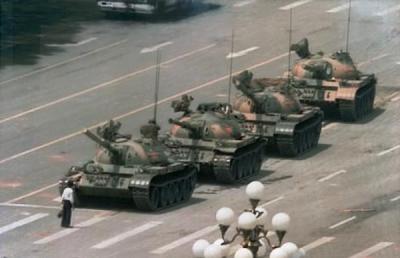A Salute to An Unknown Man's Bravery And Courage
Twenty-years ago today, one man stood alone and stopped the advance, at least temporarily, of a column of tanks in Tiananmen Square.
His amazing act of defiance, a modern-day David defying the Chinese army Goliath, has inspired me ever since.
I’ve often wondered about the lone protester and his story. Who was he? How old was he? Where did he come from? Did he have brothers and sisters? A wife? Children?
 How long had he been in the square? Hours? Days? Weeks? What was he holding in his hands?
How long had he been in the square? Hours? Days? Weeks? What was he holding in his hands?
Did he think he was going to die that day? Did he, in fact, die that day with the hundreds, perhaps even thousands, of others who were killed?
Would his act have caused his family to feel pride? Or shame? Or both?
What prompted him to stand in front of the tanks, in an incredible Mexican standoff that astonished the world?
What was he thinking and feeling as he stood there? Was he afraid? What prompted him to climb up onto the lead tank? What, if anything, did he say to those within? What, if anything did they reply?
How is he remembered in China today? As a hero? As a villain? Or both?
In a commemorative online piece about the day of the 1989 massacre, photographer Jeff Widener, who captured the tank man in a now-world-famous image, writes:
His amazing act of defiance, a modern-day David defying the Chinese army Goliath, has inspired me ever since.
I’ve often wondered about the lone protester and his story. Who was he? How old was he? Where did he come from? Did he have brothers and sisters? A wife? Children?
 How long had he been in the square? Hours? Days? Weeks? What was he holding in his hands?
How long had he been in the square? Hours? Days? Weeks? What was he holding in his hands?Did he think he was going to die that day? Did he, in fact, die that day with the hundreds, perhaps even thousands, of others who were killed?
Would his act have caused his family to feel pride? Or shame? Or both?
What prompted him to stand in front of the tanks, in an incredible Mexican standoff that astonished the world?
What was he thinking and feeling as he stood there? Was he afraid? What prompted him to climb up onto the lead tank? What, if anything, did he say to those within? What, if anything did they reply?
How is he remembered in China today? As a hero? As a villain? Or both?
In a commemorative online piece about the day of the 1989 massacre, photographer Jeff Widener, who captured the tank man in a now-world-famous image, writes:
…I reflected back to cowering behind the same bathroom wall every time a column of soldiers fired their weapons and that hellish night of June 4th following the Tiananmen crackdown. I had suffered a serious concussion after a stray rock slammed into my face. The Nikon Titanium camera had absorbed the blow saving my life.
As I ordered room service, the stale cheeseburger reminded me of how stunned I was 20 years earlier to see CNN footage of events I experienced only a few hours before on the street. I recalled how sick I was from the flu and my throbbing concussion. That feeling of guilt mixed with regret for not returning to the streets after the injury and my sheer terror of almost dying. The fact is, I was just too scared, injured and sick. The decision probably saved my life.
Isn’t it ironic that one man who was too afraid to leave his hotel room captured the arresting image of another man’s courage?
Had Jeff Widener not been terrified, that photograph, which to me encapsulates the very essence of bravery, never would have been taken…
I don’t know who that lone protester was, or if he is alive or dead.
But I salute him today, on the twentieth anniversary of his amazing act of courage, defiance and selflessness, which has inspired me, and millions of others around the world to be brave and courageous in our own ways.